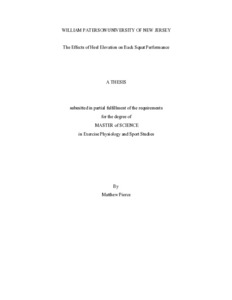Please use this identifier to cite or link to this item:
http://hdl.handle.net/20.500.12164/3353| Title: | The Effects of Heel Elevation on Back Squat Performance |
| Authors: | Pierce, Matthew |
| Keywords: | Kinesiology;Exercise and Sports Studies;Biomechanics;Electromyography;Muscle activation;Performance;Strength and Conditioning |
| Issue Date: | 2023 |
| Publisher: | William Paterson University |
| Abstract: | Heel-elevated back squats have mainly been used in rehabilitative settings, research has suggested that the exercise promotes less trunk inclination and a more stable posture, furthermore, the restricted state of plantarflexion during the exercise requires less dorsiflexion, a common restriction preventing a complete back squat. There is little research support that these suggested biomechanical effects may have an impact on back squat performance. The purpose of this study was to examine the differentiating effects of muscle activation and barbell metrics at different heel elevations (0.0 in., 0.5 in., and 1.0 in.). Utilizing a repeated measures design, 10 resistance trained individuals (N = 10, RT years: 4.85 ± 2.789) performed three sets of 10 repetitions at 70% of their 1RM at the 3 predetermined heel positions. Testing days were randomized, participants were given at least 24 hours in between each session, and participants performed the exercise barefooted to avoid any additional heel elevation. Surface electromyography was used to obtain activation for the knee extensors (RF, VM, VL) and a single inertial measurement unit (IMU) centered on the barbell was used for force-velocity metrics. Mean muscle activation normalized to participants maximum voluntary contraction (MVC), movement velocity, peak power, peak force, and concentric distance were analyzed. Paired samples and repeated measures tests were analyzed to test for differences in muscle activation comparing a participant's testing day at 0.0 inches to the days with heel elevations and if there were any enhancements in performance during heel raised conditions. Paired sample results showed significance in RF activation at 0.5 inches (p = 0.035; SD = 2.166%), VM activation at 0.5 inches (p = 0.018, SD = 7.151%) and slight significance comparing 1.0 inches (p = 0.055, SD = 9.544%), all showing a significant reduction in activation. Repeated measure results showed no significance among the obtained barbell metrics or fatigue related differences in muscle activation between sets 1 and 3. These findings support that in resistance trained individuals, biomechanical changes can affect muscle activation though not enough to alter performance. |
| URI: | http://hdl.handle.net/20.500.12164/3353 |
| Appears in Collections: | Theses & Dissertations |
Files in This Item:
| File | Description | Size | Format | |
|---|---|---|---|---|
| Pierce_HeelElevatiionEffects.pdf | 5.51 MB | Adobe PDF |  View/Open |
Items in DSpace are protected by copyright, with all rights reserved, unless otherwise indicated.
